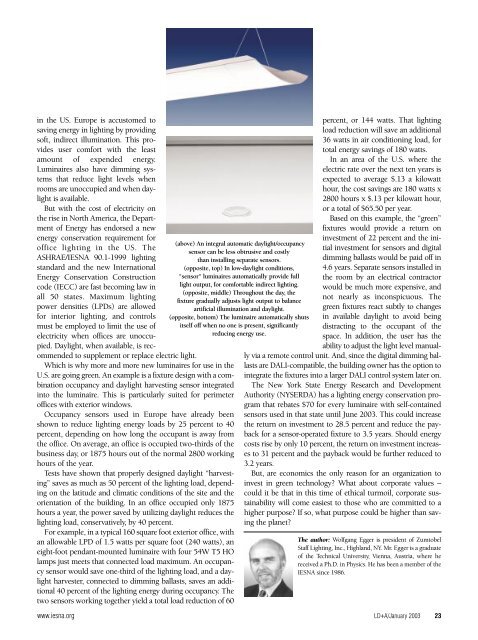From Pokemon to Tiffany's to LEED to DALI - Illuminating ...
From Pokemon to Tiffany's to LEED to DALI - Illuminating ...
From Pokemon to Tiffany's to LEED to DALI - Illuminating ...
Create successful ePaper yourself
Turn your PDF publications into a flip-book with our unique Google optimized e-Paper software.
in the US. Europe is accus<strong>to</strong>med <strong>to</strong><br />
saving energy in lighting by providing<br />
soft, indirect illumination. This provides<br />
user comfort with the least<br />
amount of expended energy.<br />
Luminaires also have dimming systems<br />
that reduce light levels when<br />
rooms are unoccupied and when daylight<br />
is available.<br />
But with the cost of electricity on<br />
the rise in North America, the Department<br />
of Energy has endorsed a new<br />
energy conservation requirement for<br />
office lighting in the US. The<br />
ASHRAE/IESNA 90.1-1999 lighting<br />
standard and the new International<br />
Energy Conservation Construction<br />
code (IECC) are fast becoming law in<br />
all 50 states. Maximum lighting<br />
power densities (LPDs) are allowed<br />
for interior lighting, and controls<br />
must be employed <strong>to</strong> limit the use of<br />
electricity when offices are unoccupied.<br />
Daylight, when available, is recommended<br />
<strong>to</strong> supplement or replace electric light.<br />
Which is why more and more new luminaires for use in the<br />
U.S. are going green. An example is a fixture design with a combination<br />
occupancy and daylight harvesting sensor integrated<br />
in<strong>to</strong> the luminaire. This is particularly suited for perimeter<br />
offices with exterior windows.<br />
Occupancy sensors used in Europe have already been<br />
shown <strong>to</strong> reduce lighting energy loads by 25 percent <strong>to</strong> 40<br />
percent, depending on how long the occupant is away from<br />
the office. On average, an office is occupied two-thirds of the<br />
business day, or 1875 hours out of the normal 2800 working<br />
hours of the year.<br />
Tests have shown that properly designed daylight “harvesting”<br />
saves as much as 50 percent of the lighting load, depending<br />
on the latitude and climatic conditions of the site and the<br />
orientation of the building. In an office occupied only 1875<br />
hours a year, the power saved by utilizing daylight reduces the<br />
lighting load, conservatively, by 40 percent.<br />
For example, in a typical 160 square foot exterior office, with<br />
an allowable LPD of 1.5 watts per square foot (240 watts), an<br />
eight-foot pendant-mounted luminaire with four 54W T5 HO<br />
lamps just meets that connected load maximum. An occupancy<br />
sensor would save one-third of the lighting load, and a daylight<br />
harvester, connected <strong>to</strong> dimming ballasts, saves an additional<br />
40 percent of the lighting energy during occupancy. The<br />
two sensors working <strong>to</strong>gether yield a <strong>to</strong>tal load reduction of 60<br />
(above) An integral au<strong>to</strong>matic daylight/occupancy<br />
sensor can be less obtrusive and costly<br />
than installing separate sensors.<br />
(opposite, <strong>to</strong>p) In low-daylight conditions,<br />
"sensor" luminaires au<strong>to</strong>matically provide full<br />
light output, for comfortable indirect lighting.<br />
(opposite, middle) Throughout the day, the<br />
fixture gradually adjusts light output <strong>to</strong> balance<br />
artificial illumination and daylight.<br />
(opposite, bot<strong>to</strong>m) The luminaire au<strong>to</strong>matically shuts<br />
itself off when no one is present, significantly<br />
reducing energy use.<br />
percent, or 144 watts. That lighting<br />
load reduction will save an additional<br />
36 watts in air conditioning load, for<br />
<strong>to</strong>tal energy savings of 180 watts.<br />
In an area of the U.S. where the<br />
electric rate over the next ten years is<br />
expected <strong>to</strong> average $.13 a kilowatt<br />
hour, the cost savings are 180 watts x<br />
2800 hours x $.13 per kilowatt hour,<br />
or a <strong>to</strong>tal of $65.50 per year.<br />
Based on this example, the “green”<br />
fixtures would provide a return on<br />
investment of 22 percent and the initial<br />
investment for sensors and digital<br />
dimming ballasts would be paid off in<br />
4.6 years. Separate sensors installed in<br />
the room by an electrical contrac<strong>to</strong>r<br />
would be much more expensive, and<br />
not nearly as inconspicuous. The<br />
green fixtures react subtly <strong>to</strong> changes<br />
in available daylight <strong>to</strong> avoid being<br />
distracting <strong>to</strong> the occupant of the<br />
space. In addition, the user has the<br />
ability <strong>to</strong> adjust the light level manually<br />
via a remote control unit. And, since the digital dimming ballasts<br />
are <strong>DALI</strong>-compatible, the building owner has the option <strong>to</strong><br />
integrate the fixtures in<strong>to</strong> a larger <strong>DALI</strong> control system later on.<br />
The New York State Energy Research and Development<br />
Authority (NYSERDA) has a lighting energy conservation program<br />
that rebates $70 for every luminaire with self-contained<br />
sensors used in that state until June 2003. This could increase<br />
the return on investment <strong>to</strong> 28.5 percent and reduce the payback<br />
for a sensor-operated fixture <strong>to</strong> 3.5 years. Should energy<br />
costs rise by only 10 percent, the return on investment increases<br />
<strong>to</strong> 31 percent and the payback would be further reduced <strong>to</strong><br />
3.2 years.<br />
But, are economics the only reason for an organization <strong>to</strong><br />
invest in green technology What about corporate values –<br />
could it be that in this time of ethical turmoil, corporate sustainability<br />
will come easiest <strong>to</strong> those who are committed <strong>to</strong> a<br />
higher purpose If so, what purpose could be higher than saving<br />
the planet<br />
The author: Wolfgang Egger is president of Zum<strong>to</strong>bel<br />
Staff Lighting, Inc., Highland, NY. Mr. Egger is a graduate<br />
of the Technical University, Vienna, Austria, where he<br />
received a Ph.D. in Physics. He has been a member of the<br />
IESNA since 1986.<br />
www.iesna.org<br />
LD+A/January 2003 23

















